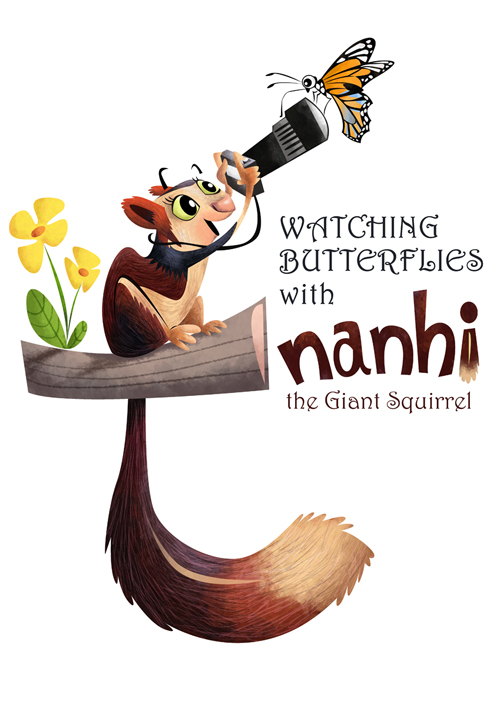
Meet Nanhi the Indian Giant Squirrel, the official mascot for Satpura Tiger Reserve.
The Satpuras, a biogeographically marvel, are a connecting link between the Western Ghats and the eastern Himalayas, and host a splendid array of wildlife unique to Central India. With a stunning diversity of butterflies (and also frogs and birds), Satpura is a ecological wonder.
The Central Indian Giant Squirrel is endemic to India and widely distributed in Western Ghats, Eastern Ghats and Central India. Satpura National Park has a huge population density of giant squirrel which is the major biosphere reserve in central India that harbors white variety of rare and make and endangered species.
The Indian giant squirrel is a maroon and blue colour and is endemic to India with four subspecies. The conservation status of Indian giant squirrel is least concerned category of IUCN giant squirrels occur across a wide range of nocturnal for this they have been reported from most of India’s, dry deciduous and riparian forest habitat fragmentation is one of the major threats which influence the giant squirrel population.
In the Western Ghats is commonly known as the Malabar giant squirrel.
KINGDOM – Animalia
PHYLUM – Chordata
SUBPHYLUM – Vertebrata
CLASS – Mammalia
ORDER – Rodentia
FAMILY – Sciuridae
GENUS – Ratufa
SPECIES – Ratufa indica
POPULATION SIZE – UNKNOWN
LIFE SPAN – 20 YRS
TOP SPEED – 32 KM/H
WEIGHT – 1.5-2 KG
LENGTH – 25-45 CM
The forest types of Satpura National Park consist of mixed deciduous forest, mixed deciduous forest and dry Peninsula’s forest.
Part of the park is hilly and highly undulating, which dominated trees species.
The faunal diversity comprises of major such as Tigers, leopards other small carnivorous including jungle cat, Palm civet.
Birds of prey like crested Hawk Eagle, Black Eagle and crested serpent eagle are the major creditors of the central India giant squirrel.
The four different species are R.affinis, R.bicolor, R.macroura and R. indica .The Indian giant squirrel, Ratufa indica is an arboreal and diurnal mammal which is endemic to India. It is widely distributed in the evergreen to mixed dry and moist deciduous forests of Western Ghats, Eastern Ghats and Central Indian Hills and Khurda Forest Division. It is a large sized squirrel having multi-coloured skin tone including grey, black, reddish brown and golden colours. Good tree cover and food plant diversity greatly influence the presence of Indian giant squirrel in tropical regions.
These rodents are generally solitary animals, occasionally living in pairs during the mating season. These cautious and shy creatures are usually active early in the morning and in the evening. During the midday, they rest in tree holes or large, globe-shaped nests, constructed out of twigs and leaves and typically located in trees. Each squirrel has 2 – 5 nests, found within a small territory. One of these nests is made exclusively for producing and nursing the young, while others are used as sleeping sites. The Indian giant squirrels also very agile animals, able to take leaps of up to 6 meters when travelling among trees.
The reproductive habits and behavior of this species is insufficiently explored, although males are known to compete for their mating rights. Occasionally, pairs remain together for long periods of time. Indian giant squirrels breed either year-round or several times per year. Gestation period is likely to last 28 – 35 days, yielding 1 – 2, sometimes 3 young. The young are nursed and grown in nests, located on tree branches. Their nests are as large as these of eagles. After a while, young squirrels start coming out of the nest and soon they become independent.
Due to feeding upon a wide variety of plants, these rodents act as key seed dispersers of these species, thus benefiting the local ecosystem.
Fun Facts for Kids
- The long tail helps this rodent keep balance when moving around.
- A male Indian giant squirrel is called a ‘buck’, a female is referred to as a ‘doe’, whereas offspring is called a ‘pup, kit or kitten’. A group of these rodents is known as a ‘dray or scurry’.
- When threatened, these animals typically remain motionless. When it happens on the ground, they usually flee to a tree and climb up to it for shelter. When threatened in a tree, they embrace the tree trunk, clinging to the bark with their body.
- Squirrels are highly approachable and very friendly creatures. Unlike most wild animals, they can be hand-fed.
- When threatened, these smart rodents confuse a predator by running in various directions.
- The primary forms of communication are vocalizations and scent. In addition, they are known to give signals with their tails, usually twitching them in order to warn of a threat.